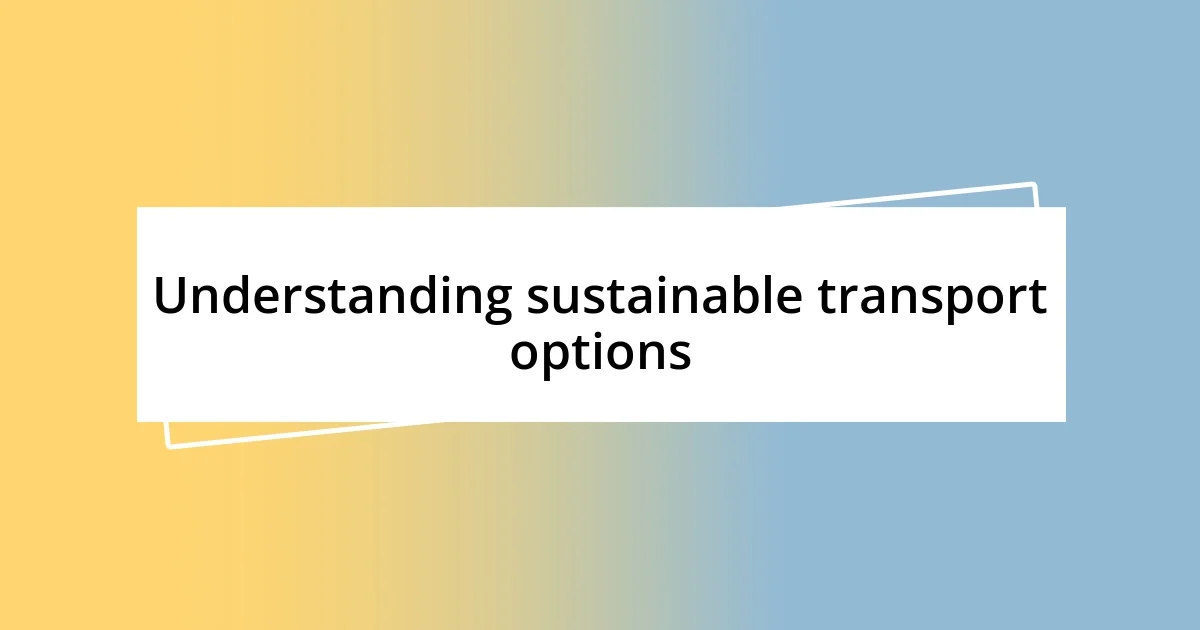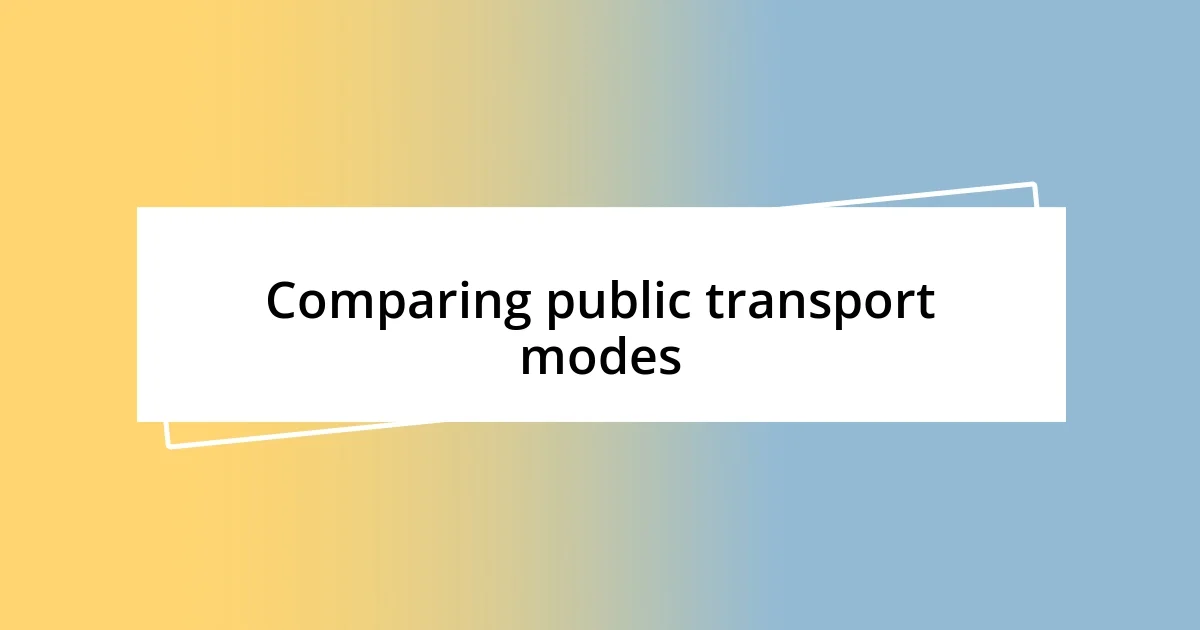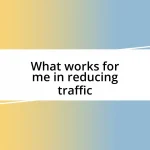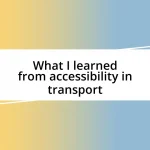Key takeaways:
- Sustainable transport options, such as public transit, cycling, and carpooling, reduce environmental impacts and enhance urban experiences.
- Key benefits of sustainable public transport include reduced emissions, cost-effectiveness, community engagement, and improved traffic management.
- Future trends in public transport focus on technological innovations, renewable energy integration, and creating supportive infrastructure to promote sustainable choices.

Understanding sustainable transport options
Sustainable transport options are fascinating because they address two key issues: reducing environmental impacts and enhancing our urban experiences. I remember a time when I took a bike-sharing program in my city. The fresh air and the feeling of gliding effortlessly down bike lanes made me realize how something as simple as cycling could transform both my commute and my perspective on urban living.
When thinking about sustainable transport, we often consider public transit systems like buses and trains that run on cleaner energy sources. Have you ever ridden a hybrid or electric bus? It’s not only quieter but also gives you a sense of satisfaction knowing you’re contributing to lower emissions. Such alternatives allow us to engage with our surroundings while reducing our carbon footprints, making journeys feel more like a shared community adventure rather than just a means to an end.
There’s a depth to understand when discussing options like carpooling or investing in electric vehicle infrastructure. Imagine the camaraderie built through shared trips; it feels more personal and less like a race against time. The emotional connection we build with our fellow commuters shifts our perception of travel—from a mundane necessity to an opportunity for connection and positive impact.

Benefits of sustainable public transport
Sustainable public transport offers numerous advantages that extend beyond mere convenience. I recall a time when I hopped on a local tram instead of driving. The ride was smooth, and I noticed how vibrant the streets looked from my window. I felt more connected to my community and its rhythm, which is something that driving alone in a car simply cannot replicate.
Here are some key benefits of sustainable public transport:
– Reduced Emissions: Public transport can significantly lower greenhouse gas emissions, directly benefiting air quality.
– Cost-Effective: Utilizing buses or trains often comes at a fraction of the cost of maintaining a personal vehicle.
– Space Efficiency: Public transport can carry many passengers at once, conserving urban space compared to individual cars.
– Effective Traffic Management: A robust public transit system helps reduce congestion, making travel smoother for everyone, including those who still drive.
– Community Engagement: Riding public transport fosters a sense of community, as you encounter diverse individuals and stories, enriching your daily life.
By choosing sustainable options, I can’t help but feel that I’m part of a larger solution for our cities—a collective effort to address urban challenges while enhancing our quality of life.

Key components of sustainability
Sustainability in public transport hinges on several core components that intertwine to create a more holistic approach. One of the fundamental elements is the shift towards renewable energy sources. I remember attending a seminar where a speaker discussed the benefits of solar-powered buses, and the excitement was palpable in the room. Imagine a fleet of buses silently gliding around the city, powered by the very sun above us! It’s innovations like these that can dramatically lessen our reliance on fossil fuels.
Another critical aspect is accessibility. Public transport must be equitable and available to all, regardless of location or economic status. I once volunteered with a local organization working to enhance transport options for underserved communities. Witnessing individuals, who had struggled with unreliable transport, gain access to jobs and services felt incredibly rewarding. Making systems inclusive not only strengthens communities but actively involves everyone in the sustainable journey.
Lastly, integrating technology plays a crucial role in enhancing sustainability. Smart traffic systems and real-time data can optimize routes for buses and train services. I’ve been in cities where apps provide live updates on public transport, making it easier to plan my commutes. This not only improves efficiency but also encourages people to opt for public transport instead of personal vehicles, turning the idea of sustainability from a concept into a daily choice.
| Key Component | Description |
|---|---|
| Renewable Energy Sources | Utilizing energy that can be replenished, such as solar or wind, to power public transport systems. |
| Accessibility | Ensuring public transport is available to all members of the community, addressing barriers to usage. |
| Technology Integration | Employing technology to enhance efficiency and reliability in public transportation systems. |

Comparing public transport modes
When evaluating public transport modes, it’s fascinating to see the variety of choices that communities can offer. For instance, I once took a high-speed train from one city to another, marveling at how quickly we zipped past landscapes while being fully relaxed. The convenience of trains is hard to match, and they are an excellent choice for long distances, as they efficiently transport a large number of passengers without the stress of traffic jams.
Buses, on the other hand, often serve as the lifeline for urban mobility, connecting neighborhoods that might not have train access. I recall waiting at a bus stop during a rainy afternoon, sharing stories with other commuters about our plans for the weekend. That human connection made the wait feel shorter and highlighted how buses can foster community interactions in a way that trains simply can’t replicate. Plus, the flexibility of bus routes allows for easier adjustments to urban growth compared to fixed rail lines.
Then there’s the option of biking, which I’ve embraced during my weekend explorations. Riding through bike lanes, I felt a rejuvenating sense of freedom, not to mention the physical and mental health benefits such as increased fitness and reduced stress. Isn’t it incredible how choosing a bike can transform a mundane trip into a mini-adventure? Each mode of transport has its unique strengths and challenges, making the decision about which to use an important one based on personal preferences as well as community needs.

Challenges of implementing sustainability
One of the significant challenges of implementing sustainability in public transport is the funding gap. I’ve worked with various organizations where we constantly discussed budget constraints. When I learned about the high initial costs of establishing renewable energy systems, such as solar panels for buses, it became clear that financial support is essential. How can we expect cities to adopt green technologies without adequate funding?
Another hurdle is resistance to change among stakeholders. I remember attending a community meeting where a long-time bus driver expressed skepticism about the proposed changes to bus routes and services. It struck me then how vital public buy-in is for these initiatives to succeed. Convincing people to embrace new methods and technologies isn’t just about presenting the facts; it’s about addressing their concerns and showing them the tangible benefits.
Lastly, there’s the challenge of coordinating efforts across different jurisdictions. During a recent event, the conversation shifted to how fragmented transit systems can confuse users. I realized that a seamless experience is paramount for encouraging people to utilize public transport. The struggle to integrate various transport modes into a cohesive network can leave commuters frustrated, potentially pushing them back to their cars, which completely undermines sustainability efforts. How can we truly create holistic solutions if we can’t effectively communicate and coordinate as a unified front?

Future trends in public transport
The future of public transport is undeniably exciting, with technological innovations shaping the way we move. I recently had a chance to experience an app-controlled electric shuttle service, and I was amazed at how seamlessly it integrated into my daily routine. It made me wonder, could this be a glimpse of a world where on-demand services could solve our urgent commuting woes?
Autonomous vehicles are also on the horizon. Just the other day, I watched a video showcasing driverless buses navigating city streets. It sparked a mix of fascination and concern in me. Will people feel comfortable hopping onto a bus without a driver, or will it take time to build that trust? I think the key will be ensuring safety measures are transparent and that the technology is reliable, making it less about machines taking over and more about enhancing our travel experience.
Finally, sustainable energy solutions like solar power are gradually becoming mainstream in public transport. On my last trip, I noticed solar panels installed on a city bus depot, igniting my hope that cities are making real strides toward greener alternatives. What if all buses and trains operated on renewable energy? The potential for reduced emissions is a game-changer, but it requires commitment and collaboration among various stakeholders. I’m just curious—how early will we see these innovations redefine our daily travels?

Strategies for promoting sustainable choices
One effective strategy for promoting sustainable choices is enhancing public awareness through educational campaigns. I recall a time when my community organized a “Green Transport Week,” showcasing the benefits of using public transit, biking, and walking. It was eye-opening to see how a well-structured event could shift attitudes and reveal how simple changes in daily habits can significantly reduce our carbon footprint. Have you ever participated in a local initiative that opened your eyes to sustainable options?
Another approach is incentivizing the use of eco-friendly transport options. In my city, I once took part in a program where commuters received discounts for using public transit or biking. Seeing how these incentives prompted more people to leave their cars at home was inspiring. It made me wonder, how could financial incentives be scaled to encourage even greater participation?
Lastly, it’s essential to create infrastructure that supports and nurtures sustainable choices. I have walked through neighborhoods where bike lanes are clear and well-maintained, and I noticed how it encouraged more cyclists. What if every city prioritized safe tracks for cyclists and pedestrians? It’s an exciting thought that could transform urban landscapes and truly enhance our public transport systems.














